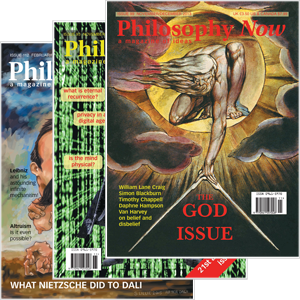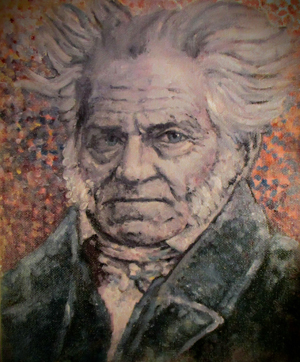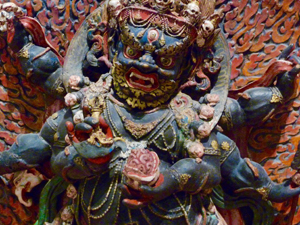
Your complimentary articles
You’ve read one of your four complimentary articles for this month.
You can read four articles free per month. To have complete access to the thousands of philosophy articles on this site, please
Articles
Weltschmerz and the World
Ian James Kidd takes a realistic and global view of the history of pessimism.
The most famous pessimist in the history of philosophy is surely Arthur Schopenhauer (1788-1860). In his most important work, The World as Will and Representation (1818) he describes our existence as ‘a mistake’ and ‘the worst of all possible worlds’, explaining that, except in occasional moments of artistic delight, humans are trapped in an endless painful cycle of desire, frustration, and boredom. For Schopenhauer, “pain, not pleasure, is the positive thing, pleasure being merely its absence” and life, if properly understood, “ought to disgust us”. Alongside suffering and distraction, our overall moral condition is also terrible: other than a few ‘beautiful souls’, people are dominated by “vices, failings… of all sorts”, and the social world is a “den of thieves”. Suicide is morally ruled out, so our only path to redemption is to try, however futilely, to transcend the will that relentlessly drives all things. True to his pessimism, though, this transcendence is confined by Schopenhauer to an elite group – to ‘saints and geniuses’ – condemning the rest of us to the hell of human existence. While Schopenhauer is the most famous pessimist, he was not the only pessimist in nineteenth century Germany, nor was he considered the most important at the time. Excellent recent studies of the history of pessimism – such as Frederick Beiser’s Weltschmerz (‘ World-pain’, 2016) – challenge the Schopenhauer-centred picture, reminding us of other, now-forgotten figures.

Arthur Schopenhauer by Woodrow Cowher
The ‘Pessimism Controversy’ of late 1800s Germany had many such figures, and their worries about ‘the value of existence’ did not come out of nowhere. New and powerful forms of the problem of evil, the rise of materialist philosophies, and a crisis in Christian faith brought about by higher Biblical criticism, all helped to reactivate questions about the meaning and value of human life as old as the Greeks. Sophocles (496-406 BCE), for instance, posed the stark possibility that the best thing for a human is ‘never to have been born’ – an attitude recently revived by anti-natalist philosophers, led by David Benatar, perhaps the most famous living pessimistic philosopher.
The history of pessimism, then, is much wider than the life and work of Arthur Schopenhauer. It goes back at least to the Greeks. Other more recent candidates for the title ‘pessimist’ include Montaigne, Rousseau, and Hobbes, and the early Church Fathers, who saw the human condition as an ill one, dominated by ‘vices and crimes’. Other exemplars include Giacomo Leopardi (1798-1837), the Italian poet who regarded humanity as ‘necessarily unhappy’, and the Romanian aphorist Emil Cioran (1911-95), whose pessimism is apparent in the titles of his books, such as The Heights of Despair (1934).
Plenty of pessimists, then, ancient and modern.
Pessimism Pervasive
The pessimists disagree on what is wrong with being human and what to do about it. For instance, many Christians hope that a life of trusting in Christ ensures redemption; but we still have to toil through ‘the misery of the human condition’, as St Augustine called it. Nor are all pessimists committed to offering paths to redemption. Eduard von Hartmann, for one, advised ‘universal suicide’, and Reddit is full of nihilistic pessimists who eagerly await human extinction. It’s an extreme view, for sure, but in a world which seems to warrant pessimistic conclusions, they should not be perfunctorily dismissed.
Suffering and nihilism, worries about suicide, and questions about the meaning of life in a world apparently without divine redemption but with human evils – this is all part of what Joshua Dienstag calls the ‘problematic’ of pessimism (Pessimism, 2006).
It’s clear the West has tried to describe and cope with the pessimism problem. For sure nineteenth century Germany was, as Beiser judges, “ the era of pessimism, the epoch of Weltschmerz.” What about other cultures, though? Can we find pessimistic themes outside of post-Christian Europe? Are there non-Western pessimists, who were not grappling with theism and the problem of evil, but who, nonetheless, recognised the misery of the human condition?
I think the answer to these questions is ‘Yes’, and that this matters to our thinking about pessimism. Pessimism is not confined to the Western philosophical tradition, and there are lots of other sources. Some involve Christianity or theism more generally, but others don’t. Some sorts of pessimism insist that life lacks meaning, others don’t.
If we take a more multicultural perspective, we’ll find other instances of philosophical pessimism. Even better – if that’s the right word – we will appreciate that pessimism isn’t an existential ‘problem’ unique to Westerners. It’s a conclusion on the nature of human life that has been reached by many reflective people around the world. But first, we need a working definition of ‘pessimism’.
What Is Pessimism?
What is pessimism? It’s too broad to say that a pessimist is someone who calls attention to the dark sides of life. All but the most zealous optimist can do that. It would also, however, be too narrow to define pessimism as a response to a sense of the meaninglessness of life in a world where people now must struggle to answer the question of why they should live if God is dead.
Inevitably, philosophers offer different definitions of pessimism. One thing that’s crucial, though, is that philosophical pessimism is not an emotion or a character trait. Rather, pessimism is a judgement – a rational appraisal of the human condition, grounded in experience and reflection. Of course, like any value judgement, a pessimistic one can express itself in emotions. Disquiet, despair, frustration, bitterness, and sadness are all mentioned by philosophical pessimists (as are positive emotions and moods such as acceptance and calm).
If pessimism is a judgement, this implies that no one is born a pessimist. After all, no one is born with a philosophical appraisal of the human condition. It will take years of reflection, deliberation, and maybe study, before a person can come to that judgement. There may however be people temperamentally inclined toward ways of thinking that can lead to pessimistic judgements. Dienstag suggests pessimism begins in a ‘sensibility’ that directs attention to the darker sides of life, which if dwelt on, becomes the basis for pessimistic thoughts. Those without this sensibility are, however, still capable of reaching pessimistic verdicts.
In his recent book, Pessimism, Quietism and Nature as Refuge (2024), the British philosopher David E. Cooper argues that the pessimistic judgement on human life in fact involves two distinct judgements. The first is that the human condition has entrenched features that are destructive of the possibility of achieving and sustaining deep human goods – happiness, meaningfulness, or tranquility, say. These features could include the ‘absurdity’ described by some existentialists, the various miseries and sufferings described by Schopenhauer or Leopardi, or the whole variety of the pains, distractions, frustrations, and other negative experiences that are woven into human life. Yet although different pessimists disagree on what the relevant features are, they will agree that they’re built into the human condition and constantly thwart our efforts to achieve a satisfying life.
A second crucial pessimistic judgement, according to Cooper, is that there is little to no chance of these features changing, or being changed, for the better, at least through human activity. For the pessimist, the human condition is a bad one and it’s not going to get better to any significant degree. There may be relatively small improvements that human beings can make on a personal scale, such as cultivating certain virtues or achieving certain kinds of tranquility. But these are fragile, and even when successful, fall short of constituting a significant overall improvement in the human condition. (Interestingly, some pessimists allow that there could be a significant change in the human condition for the better, just not one brought about by human beings. For instance, in his later writings, Martin Heidegger cryptically suggested that “only a God can save us”; and Christian pessimists do anticipate a coming Kingdom of God. Alternatively, some modern eco-pessimists suggest that while this civilization is finished, its end could initiate a moral renaissance for humanity. In that scenario, future people would be free of the competitiveness and greed that make our condition such a bad one.)
For Cooper, holding these two judgements – of there being entrenched negatives in life, and of there being no evident possibility of imminent change – are necessary for a person to count as a philosophical pessimist. One attraction of this account is its ability to accommodate a whole range of pessimistic philosophies. It’s also neutral with reference to the specific implications of pessimism for human life. A conviction that the human condition can’t be substantially improved, for instance, is consistent with nihilism, but doesn’t require it. It could also be used to justify anti-natalist policies, but not necessarily. Cooper’s account also lacks some features that certain pessimists want to add, such as the anticipation of deterioration – the conviction that the human condition will get worse over time. Van der Lugt calls this ‘future-oriented pessimism’. It can be justified by appeal to cosmology, the poor track record of human beings, or claims about human nature. However, anticipation of deterioration need not be built into philosophical pessimism. It is, after all, very difficult to justify confident claims about the future course of human events.
I’d say that philosophical pessimism consists of Cooper’s pair of judgements on the human condition, while the exact content of a pessimistic doctrine is supplied by the specific philosophy or religion in which it occurs – Christianity, German metaphysics, and so on.
Indian Pessimism
With a definition of philosophical pessimism in place, a proper global search can begin for philosophical accounts of the human condition as intrinsically bad and not likely to improve.

Buddhist wrathful deity Andrea Kirkby 2015 Creative Commons 2
Ancient India is a good place to start. Pessimism largely characterises ancient Indian philosophy and religions. Only one school, the Lokāyata, rejected gloomy appraisals of human life. Materialists and hedonists, they apparently dismissed concerns for salvation, believed in neither heaven nor hell, and urged us to choose ‘delicious food’ over ‘penance and fasts’. However, the majority of India’s darśanas (schools) agreed that the condition of most people is bad, dominated by dukkha – a term widely translated as ‘suffering’, ‘dis-ease’, ‘alienation’, or ‘pain’. Since most of us are trapped in powerful webs of ignorance and illusion, our prospects for escape are dim. Different schools, naturally, express this idea differently. In Advaita Vedānta, what’s needed to overcome delusion and sorrow is appreciation of Brahman: ‘supreme and unconditioned’ reality. But there is an even better example of Indian philosophical pessimism – the discourses of the Buddha.
In the modern West, depictions of Buddhism are solidly optimistic. Most of these focus on positive themes such as mindfulness and ecological concern, and the rhetoric is of wisdom, compassion, and joy. All this is very distant from the Buddha’s own teachings as found in the Pali Canon. Like his Indian contemporaries, the Buddha (c. sixth century BCE) described the lives of ‘uninstructed worldlings’, like you and me, in grim terms – ‘burning’ with the ‘fires’ of hatred, greed, and self-delusion, feeding ‘suffering, anguish, and disaster’. Unenlightened existence is compared to being trapped in a whirlpool, or like a dog chained to a post, desperately trying to escape. Existence, the Buddha taught, is suffering, since anxiety, ‘grasping-desire’, and disappointment cannot be removed from our ignorant forms of life. Worse, all unenlightened people are corrupted by ‘cankers’, ‘defilements’, and failings of all kinds. For the Buddha, unenlightened human existence is full of features – from ‘grasping-desire’ to ignorance to ‘cankers’ and ‘defilements’ – that make it a bad one.
The Buddha also responds to the optimistic thought that enlightenment, and hence release, are possible. For most of us, though, enlightenment is a dim and distant prospect, and the long, hard path to it, demands degrees of commitment and sacrifice few possess. Indeed, the Buddha is clear that enlightenment is fantastically rare. Most of us, therefore, remain trapped within forms of life dominated by anxiety and craving, frustration and ignorance – ‘taints and wrong views’ which intensify one another in a ‘fire’ without end. The Buddha also accepted the optional pessimistic conviction that the moral and spiritual state of the world will deteriorate: over time, the Buddha will be forgotten, his Dharma (teachings) distorted, and the Sangha – the monastic community – will fall into corruption and disorder: a dire result the Buddha called ‘the death of the Dharma’.
Far Eastern Pessimism
Looking further east, pessimism was also central to classical Chinese philosophers, and not simply because they were living in the Warring States Period (c.475-221 BCE). During this time, both Confucianism and Daoism lamented the decline of the Way, even if their analyses of the wrongs of the world differed.
For Confucius, virtue and harmony were failing in the face of jealousy and competitiveness, the corrupting lust for power, the abandonment of reverence for the wisdom of tradition, and the philistine contempt for edifying arts, such as music. Worse still, such vices and miseries seemed inescapable. Daoists, by contrast, saw the world as dominated by zeal for artifice, cleverness, and the imperative to impose our own ways onto people, creatures, and natural environments. In the Daodejing, this idea is presented in terms of a narrative of deterioration, as people increasingly abandon the Way of Heaven.
The Daoist philosopher Zhuangz i (c.369-286 BCE), too, offers us bleak assessments of the human condition – as restless, acquisitive, relentless – and laments ‘How sad!’ But while Confucius advised earnest efforts to reinstate virtue and goodness, Zhuangzi’s stance is quietist, Let go of the world, abandon plans and schemes for moral reform, and exercise humility, spontaneity, and other quietist virtues.
Other classical Chinese philosophies endorse pessimist perspectives on human existence too, especially tough-minded ‘Legalists’ like Han Fei (280-233BCE).
A Pessimistic Conclusion
So pessimism is present in different forms in both the Indian and Chinese traditions. My claim is not that all the Indian darśanas and Chinese schools were pessimistic. Lokāyata is one exception in India, and Mohism may be another in China. Still, there were philosophical pessimists in ancient India and China, which would prove that the pessimistic ‘sensibility’ or ‘problematic’ isn’t confined to Westerners of the last three hundred years.
The history of philosophical pessimism is, then, a global history. It should include ancient Greeks, medieval Christians, the more recent European pessimists, as well as figures and traditions from India, China, and elsewhere. The history should also include Mesoamerican traditions. According to their surviving texts, the Nahua (Aztecs) depicted human life as ‘slippery’; happiness is precarious and the wise person ‘weeps’ and feels ‘deep sorrow’.
A world history of pessimism, while interesting, would also confirm a disquieting truth: reflective men and women around the world, with significantly different assumptions and concerns, consistently arrive at pessimistic conclusions on human life. But whether we endorse or challenge those conclusions, there is more to pessimism than the specific Western Weltschmerz of people suffering ‘the death of God’.
© Dr Ian James Kidd 2025
Ian James Kidd teaches and researches philosophy at the University of Nottingham, and is writing a book on misanthropy. His website is ianjameskidd.weebly.com.









